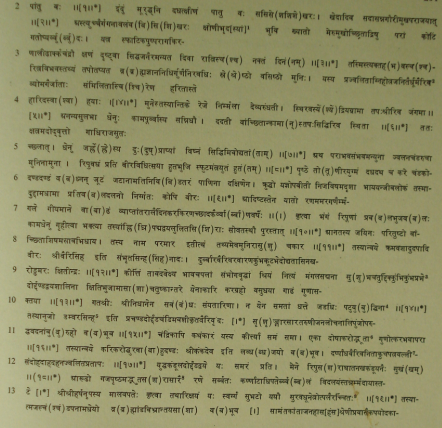| |
North
Indian Inscriptions |
| |
|
|
|
INSCRIPTIONS OF THE PARAMARAS OF VAGADA
ARTHŪNĀ STONE INSCRIPTION OF CHĀMUNḌARĀJA

_______________________________________________________________
[1] The aksharas in the square brackets, here and also below, are either so damaged as to be read on the
stone, or are not properly formed, and those marked with stars are supplied from the context.
[2] Barnett read the preceding word as jvalitair-, but the syllables are exactly as transcribed here. His reading would also offened against the metre.
[3] Barnett corrected bhē to bhau, but it is not necessary as this expression has to be taken as governing
antarē (the periphery of the four quarters) adorned with water-pots in the form of the frontal globes of
elephants. It is customary to place water-jars in a maṇḍapa in marriage-ceremonies.
[4] Here is a pun one the word jaladhi, which means (1) occan and (2) of dull intellect (jaḍadhī). ḍa and la
being used for each other.
[5] Prosodically, the first syllable of the name is required to be laghu, and, as suggested by the editor, the
reading Damarasiṁha would suit the metre.
[6] The mātrā of shā was inserted later on. The word is here used in double sense : (I) dōshā meaning
the night. and (2) dōsh-ākara meaning a mine (full) of faults.
[7] Here is a kāka-pada not a daṇḍa as taken by Barnett; it is intended to show that the word is con-
tinued in the next line. In the name Kaṁka that precedes, both the aksharas are marked by serifs at the
lower extremity.
[8] The reading is certain. From the indifferent impression the letters were read by Barnett as gaja-pṛishṭha-
vāhuta(ahata ?)
[9] Originally तै:, with the sign of mātrā erased so lightly as to show the remains. As noted by Barnett.
the first syllable in this line is engraved outside its proper border.
|
\D7
![]()
|








